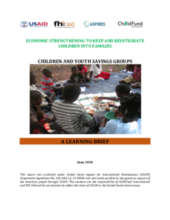Introduction
This Learning Brief draws on project documents,focus group discussions and individual interviews to document ChildFund International’s experience with Children and Youth Savings Groups for highly vulnerable children in Uganda’s Kamuli, Luwero and Gulu Districts through the Economic Strengthening for Families (ESFAM) Project. ESFAM, funded by USAID’s Displaced Children and Orphans Fund (DCOF) through FHI 360’s Accelerating Strategies for Practical Innovation and Research in Economic Strengthening (ASPIRES) project from November 2015 to June 2018, aimed to pilot and assess different economic strengthening interventions in programming aimed at preventing child-family separation and reintegrating separated children in their families and communities. The 700 families targeted by the project were invited to participate in one of three household-level intervention packages, based on an assessment of the level of their economic vulnerability: a package including limited-term cash transfers plus optional participation in a saving group, one offering a bank savings account with matching deposits and one involving VSLA participation. All packages included case management, development of family plans, and home visits including counseling and coaching on social and economic issues by para-social workers (PSWs), training on child protection and parenting skills, and psychosocial support.
In addition to the household-level packages, ESFAM offered a savings intervention for children from targeted families themselves. The Child and Youth Savings Groups (CYSGs) described in this Learning Brief used a methodology adapted from that of the project’s adult savings groups. CYSGs were incorporated into the project with the aim of fostering the self-confidence and social resilience of young people targeted by the project, as well as other children from their communities, and increasing social cohesion among group participants. CYSGs were also intended to build children’s and adolescents’ financial literacy and money management skills and develop a habit of saving for educational and other needs. Project PSWs and Economic Strengthening Facilitators (ESFs) mobilized children during their supportive home visits with families participating in the project. In conversations and financial education sessions with caregivers and children during these home visits, PSWs and ESFs mobilized children to join these groups and invited other children in their communities to also participate.
ESFs organized boys and girls into mixed-gender groups by age cohort: children 10-13 years old and youth 14-17 years old. Between January and April 2017, they formed 27 CYSGs comprising 225 young people (male 115 and female 110, 99 children and 126 youth) from families targeted by the project and 206 children and youth from other families in those communities. Each CYSG had about 25 members and met on a weekly basis for about 45 minutes, generally on a weekend afternoon outside of school hours. Groups were involved in saving only; groups made no loans and therefore did not generate profits for members. The life cycle for each CYSG was between 9 and 12 months and concluded with the distribution, or “share-out,” of each member’s personal savings. Each group decided when its share-out would take place; for example, some groups decided their share-out should coincide with the beginning of the school term. In addition to the saving activity, CYSGs followed the Catalyzing Business Skills for Children and Catalyzing Business Skills for Youth curricula created for ESFAM by partner Making Cents International. These age-appropriate curricula included financial literacy and business skills training and coaching. Training emphasized the importance of obtaining money through safe means. Groups shared out member savings between December 2017 and March 2018.
None of the CYSGs dissolved prior to share-out and only 2 of the 225 total members from the 27 groups dropped out. District leadership promised to continue supporting the groups, through the work of Community Development Officers, after ESFAM ended its project activities with participants in March 2018 and agreed to organize new groups in villages that the project did not reach. After project implementation, the CYSG participants’ communities, in collaboration with children’s caregivers and sub-county Community Development Offices, are assisting CYSGs to continue to function. Most CYSGs started a second saving cycle.

